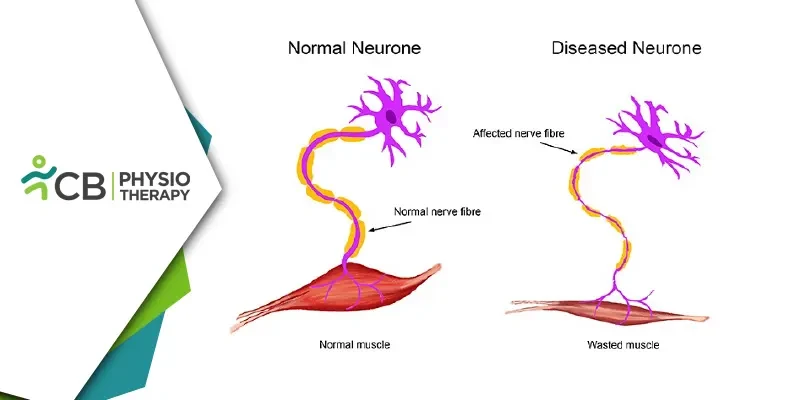Motor Neuron Disease (MND), also known as Amyotrophic Lateral Sclerosis (ALS), is a progressive neurodegenerative disorder that affects the motor neurons in the brain and spinal cord. This devastating disease leads to muscle weakness, atrophy, and ultimately, paralysis. While there is currently no cure for MND, various treatment modalities aim to improve the quality of life and slow down the progression of the disease. One such vital component of MND management is physiotherapy. In this blog post, we will delve into the role of physiotherapy in the management of Motor Neuron Disease, exploring its benefits and techniques that can make a significant difference in the lives of MND patients.
Motor Neuron Disease
Motor Neuron Disease is a rare, yet severe condition that impacts the nerve cells responsible for controlling voluntary muscle movement. These motor neurons gradually degenerate and die, leading to a loss of muscle function and coordination. MND can manifest in various forms, with ALS being the most common type. Other subtypes include Progressive Bulbar Palsy (PBP), Primary Lateral Sclerosis (PLS), and Progressive Muscular Atrophy (PMA). The exact cause of MND is not yet fully understood, and there is currently no cure.
Role of Physiotherapy in MND
Physiotherapy plays a crucial role in the management of Motor Neuron Disease by addressing the physical challenges and complications associated with the condition. While physiotherapy cannot halt the progression of MND, it can significantly enhance the patient's quality of life, slow down muscle deterioration, and provide much-needed support to manage the symptoms effectively. Here are some key ways in which physiotherapy benefits MND patients:
1: Muscle Strength and Endurance: Physiotherapists design customized exercise programs that focus on maintaining and improving muscle strength and endurance. These exercises help counteract muscle wasting and prevent joint contractures, which are common in MND patients.
2: Range of Motion: MND can lead to muscle stiffness and reduced joint mobility. Physiotherapy interventions include stretching exercises to improve and maintain the range of motion, ensuring that patients can move more comfortably and independently.
3: Respiratory Care: As MND progresses, it can affect the muscles responsible for breathing, leading to respiratory difficulties. Physiotherapists teach breathing exercises and techniques to enhance lung capacity and support respiratory function. They also educate patients and caregivers on using assistive devices like BiPAP machines.
4: Posture and Balance: Maintaining proper posture and balance is essential to prevent falls and injuries in MND patients. Physiotherapists provide exercises and strategies to help patients maintain their balance and posture, reducing the risk of falls.
5: Pain and discomfort: Physiotherapy can include modalities such as Heat and Cold therapy, as well as manual techniques like massage, and modalities like TENS, to alleviate pain and improve overall comfort.
6: Assistive Devices: Physiotherapists evaluate the need for assistive devices like wheelchairs, walkers, and braces. They also offer guidance on using these devices safely and effectively to enhance mobility and independence.
Physiotherapy Techniques for MND
Physiotherapy for MND is highly individualized, tailored to the patient's specific needs and stage of the disease. Here are some common techniques used by physiotherapists in the management of MND:
1: Range of Motion Exercises: Gentle, controlled movements to prevent joint stiffness and improve flexibility.
2: Strengthening Exercises: Targeted exercises to maintain muscle strength and delay muscle atrophy. Resistance bands and weights may be used.
3: Balance Training: Balance exercises help patients maintain stability and reduce the risk of falls.
4: Breathing Exercises: Techniques to enhance respiratory function and manage shortness of breath.
5: Hydrotherapy: Aquatic therapy in warm water can provide relief from muscle stiffness and promote relaxation.
6: Electrical Stimulation: Some patients benefit from electrical stimulation to maintain muscle function.
7: Manual Techniques: Hands-on therapies like massage and myofascial release can help alleviate muscle pain and tension.
8: Postural Training: Techniques to maintain proper posture, especially while sitting in wheelchairs or using other assistive devices.
Motor Neuron Disease is a debilitating condition that poses significant challenges to patients and their families. While there is no cure, the role of physiotherapy in managing MND cannot be overstated. Physiotherapists play a crucial role in enhancing the quality of life for MND patients by addressing muscle strength, mobility, breathing, and pain management. Their individualized treatment plans, coupled with education and support, offer a ray of hope and comfort to those affected by this devastating disease. Through a combination of exercise, therapeutic techniques, and emotional support, physiotherapy helps MND patients maintain their independence and live their lives to the fullest for as long as possible.

